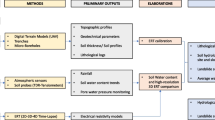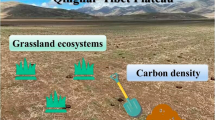Abstract
The widespread hillslope failures largely depend on the degree of weathering. Different weathering processes, especially chemical weathering, are the consequence of the variation of climatic factors, e.g., temperature and precipitation. The present study describes the various chemical and mineralogical properties of bedrock and soil samples from granite and granodiorite landslide areas under continental temperate, temperate and subtropical climate regions in central to southwestern Japan. The XRD and SEM–EDS analyses were carried out for mineralogical and chemical analyses. It is evident that bedrock samples contain quartz, k-feldspar, plagioclase, biotite and amphibole, whereas the slip surface and the upper surface soil samples are enriched with kaolin minerals, mica clay minerals and vermiculite or 14 Å intergrade minerals. Mobile elements showed decreasing values, whereas immobile elements showed increasing values with progressive weathering due to leaching (dissolution of cations) in all studied areas. The analysis of weathering indices indicated weathering progress in the order from bedrock, slip surface and upper surface soil. The relationship of mean annual air temperature and precipitation for 30 years (1981–2010) with CIA and Si–Al ratio indices showed that CIA values increased and Si–Al ratio decreased with increasing temperature whereas, precipitation did not follow that identical trend. Therefore, temperature is the key factor for chemical weathering in all cases and is more prominent on granodiorite areas than granite areas.

(modified after National Geographic World Map; 2017)









Similar content being viewed by others
References
Akinori H (1999) Analyzed the alterations in granodiorite through experimental chemical weathering. Clay Sci 38:233–245
Arel E, Tugrul A (2001) Weathering and its relation to geomechanical properties of Cavubasi granitic rocks in northwestern Turkey. Bull Eng Geol Env 60:123–133
Arndorff L (1993) Lateral relations of deltaic paleosols from the Lower Jurassic Ronne formation on the island of Bornholm, Denmark. Paleogeogr Paleoclimatol Paleoecol 100:235–250
Baumler R, Zech W (2000) Quaternary paleosols, tephra deposits and landscape history in South Kamchatka, Russia. CATENA 41:199–215
Braga MAS, Paquet H, Begonha A (2002) Weathering of granites in a temperate climate (NW Portugal), granitic saprolites and arenization. CATENA 49:41–56
Ceryan S (2007) New Chemical weathering indices for estimating the mechanical properties of rocks: a case study from the Kürtün Granodiorite, NE Turkey. Turk J Earth Sci 17:187–207
Che VB, Fontijin K, Ernst GGJ, Kervyn M, Elburg M, Ranst EV, Suh CE (2012) Evaluating the degree of weathering in landslide prone soils in the humid tropics: the case of Limbs, SW Cameroon. Geoderma 170:378–389
Chen PY (1977) Table of key lines in X-ray powder diffraction patterns of minerals in clays and associated rocks, Department of natural resources. Geol Surv Occas Pap 21:1–66
Chen PY, Lin M, Zheng Z (1997) On the origin of the name kaolin and the kaolin deposits of the Kauling and Dazhou areas, Kiangsi, China. Appl Clay Sci 12:1–25
Chigara M, Chiba T, Matsuura S (1998) Landslide-Triggered steam explosion and debris flow at the Sumikawa spa, Akita, northern Japan, May 1997. Landslide News 11:6–11
Chigira M, Inokhuchi T (2003) Landslide triggered by August 1998 heavy rainfall, northern Japan. Landslide News 14:11–19
Chigira M, Nakamoto M, Nakata E (2002) Weathering mechanisms and their effects on the landsliding of ignimbrite subject to vapor-phase crystallization in the Shirakawa pyroclastic flow, northern Japan. Eng Geol 66:111–125
Chigira M, Mohamad Z, Sian LC, Komoo I (2011) Landslides in weathered granitic rocks in Japan and Malaysia. Bull Geol Soc Malays 57:1–6
Delvaux B, Herbillon AJ, Vielvoye L (1989) Characterization of a weathering sequences of soils derived from volcanic ash in Cameroon, Taxonomic mineralogical and agronomic implications. Geoderma 45:375–388
Durgin PB (1977) Landslides and the weathering of granitic rocks. Geol Soc Am 3:127–131
Duzgoren-Aydin NS, Aydin Malpas J (2002) Re-assessment of chemical weathering indices: case study of pyroclastic rocks of Hong Kong. Eng Geol 63:99–119
Fedo CM, Nebsitt HW, Young GM (1995) Unraveling the effects of potassium metasomatism in sedimentary rocks and paleosols with implications for paleo weathering conditions and provinence. Geology 23:921–924
Fiantis D, Nelson M, Shamshuddin J, Goh TB, Ranst EV (2010) Determination of the geochemical weathering Indices and trace elements content of new volcanic ash deposits from Mt. Talang (west Sumatra) Indonesia. Eurasian Soil Sci 43:1477–1485
Gall Q (1992) Precambrian paleosols in Canada. Can J Earth Sci 29:2530–2536
Gall Q (1994) The Proterozoic Thelon paleosols, northwest territories, Canada. Precambr Res 68:115–137
Geological Survey of Japan (1989) 1:2000,000 seamless digital geological map of Japan. https://gbank.gsj.jp/seamless
Gour D, Soumendu C, Nilanjana DC (2014) Weathering and mineralogical alteration of granitic rocks in southern Purulia district, West Bengal, India. Int Res J Earth Sci 2:1–12
Green EG, Dietrich WE, Banfield JF (2006) Quantification of chemical weathering rates across an actively eroding hillslope. Earth Planet Sci Lett 242:155–169
Gupta AS, Rao KS (2001) Weathering indices and their applicability for crystalline rocks. Bull Eng Geol Environ 60:201–221
Harnois L (1988) The CIW index: a new chemical index of weathering. Sediment Geol 55:319–355
Haskins D (2006) Chemical and mineralogical weathering indices as applied to a granite saprolite in South Africa. Geol Soc Lond IAEG 465:1–14
Hayato T, Chigira M (2006) Causes of shallow landslides of weathered granitic rocks—from the view point of weathering styles and petrologic textures. Disaster mitigation of debris flows, slope failures and landslide. In: Proceedings of the INTERPRAEVENT International Symposium. Universal Academy Press, Inc. Tokyo, Japan 2, pp 493–501
Hiiler S (2003) Quantitative analysis of clay and other minerals in sandstones by X-ray powder diffraction (XRPD). Int Assoc Sedimentol 34:213–251
Imam MH, Oguchi CT, Wakatsuki T, Ueda M (2018) Climatic influence on weathering degree of soil layer in the soil-slip scar on granitic slopes in Japan. Trans Jpn Geomorphol Union 39:325–348
Khanlari GR, Heidari M, Momeni AA (2012) Assessment of weathering processes effect on engineering properties of Alvand granitic rocks (west of Iran), based on weathering indices. Environ Earth Sci 67:713–725
Kim S, Park H (2003) The relationship between physical and chemical weathering indices of granites around Seoul, Korea. Bull Eng Geol Environ 62:207–212
Kirschbaum A, Martinez E, Pettinari G, Herrero S (2005) Weathering profiles in granites, Sierra Norte (Cordoba, Argentina). J S Am Earth Sci 19:479–493
Lee SY, Kim SJ, Baik MH (2007) Chemical weathering of granite under acid rainfall environment, Korea. Environ Geol 55:853–862
Loughnan FC (1969) Chemical weathering of the silicate minerals. J Plant Nutr Soil Sci 125:257–258
Maher K (2010) The dependence of chemical weathering rate for a range of systems. Earth Planet Sci Lett 29:101–110
Matsukura Y (1988) Cliff instability in pumice flow deposits due to notch formation on the Asama mountain slope, Japan. Zeitschrift fiir geomorphologie N.F. Berlin Stuttgart 32:129–141
Matsukura Y (1989) Weathering, rock properties and denudational processes. Trans Jpn Geomorphol Union 10:103–112
Matsukura Y, Mizuno K (1986) The influence of weathering on the geotechnical properties and slope angles of mudstone in the Mineoka earth-slide area, Japan. Earth Surf Proc Land 11:263–273
Matsukura Y, Hattanji T, Oguchi CT, Hirose T (2007) Ten year measurements of weathering rates of rock tablets on a forested hillslope in a humid temperate region, Japan. Zeitschrift für Geomorphologie, Supplementary Issue 51:27–40
Maynard JB (1992) Chemistry of modern soils as a guide to interpreting precambrian paleosols. J Geol 100:279–289
Mizuno K, Matsukura Y (1988) The influence of plasticity index and slope angle on speed of rapid type landslide. Annu Rep Inst Geosci Univ Tsukuba 14:30–33
Monma K, Kojima S, Kobayashi T (2000) Rock slope monitoring system and rock fall prediction. Landslide News 13:33–34
Neall VE (1977) Genesis and weathering of andosols in Taranaki, New Zealand. Soil Sci 123:400–408
Nesbitt HW, Young GM (1982) Early Proterozoic climates and plate motions inferred from major element chemistry of lutites. Nature 299:715–717
Nesbitt HW, Markovics G, Price RC (1980) Chemical processes affecting alkalis and alkaline earths during continental weathering. Geochim Cosmochim Acta 44:1659–1666
Ng CWW, Guan P, Shang YJ (2001) Weathering mechanisms and indices of the igneous rocks of Hong Kong. Q J Eng Geol Hydrogeol 34:133–151
Parker A (1970) An index of weathering for silicate rocks. Geol Mag 107:501–504
Price JR, Velbel MA (2003) Chemical weathering indices applied to weathering profiles developed on heterogenous felsic metamorphic parent rocks. Chem Geol 202:397–416
Raftery T (2018) Identification of clays, Australian X-ray analytical association, part 2
Regmi AD, Yoshida K, Dhital MR, Pradhan B (2014) Weathering and mineralogical variation in gneissic rocks and their effect in Sangrumba Landslide, East Nepal. Environ Earth Sci 71:2711–2727
Reiche P (1943) Graphic representation of chemical weathering. J Sediment Petrol 13:58–68
Rice CM (1973) Chemical weathering on the Carnmenellis granite. Mineral Mag 39:429–447
Roadlset E (1972) Mineralogy and geochemistry of Quaternary clays in the Numedal area, southern Norway. Norsk Geolisk Tidsskrift 52:335–369
Ruxton BP (1968) Measures of the degree of chemical weathering of rocks. J Geol 76:518–527
Sayyed MRG (2014) Lithological control on the mobility of elements during chemical weathering. Comunicações Geológicas 101:63–69
Shirozu H (1988) Introduction to Clay Mineralogy—Fundamentals for Clay Science. Asakura Shoten, Tokyo, Japan, 1–185 (in Japanese)
Sutton SJ, Maynard JB (1992) Multiple alteration events in the history of a sub-Huronian regolith at Lauzon Bay, Ontario. Can J Earth Sci 29:432–445
Tanaka K, Inokuchi T (1998) Report on the disaster by the May, 1997 Sumikawa landslide and debris flows at Kazuno city, Akita prefecture. Nat Disaster Res Rep 34:1–40
Tugrul A, Gurpinar O (1997) The effects of chemical weathering on the engineering properties of Eocene basalts in northeastern Turkey. Environ Eng Geosci 3:225–234
Udagedara DT, Oguchi CT, Gunatilake JG (2017a) Evaluation of geomechanical and geochemical properties in weathered metamorphic rocks in tropical environment: a case study from Samanalawewa hydropower project, Sri Lanka. Geosci J 21:441–452
Udagedara DT, Oguchi CT, Gunatilake JG (2017b) Combination of chemical indices and physical properties in the assessment of weathering grades of sillimanite-garnet gneiss in tropical environment. Bull Eng Geol Environ 76:145–157
UdeS Jayawardena, Izawa E (1994) Application of present indices of chemical weathering for Precambrian metamorphic rocks in Srilanka. Bull Int Assoc Eng Geol 49:55–61
Vogel DE (1975) Precambrian weathering in acid metavolcanic rocks from the superior province Villebon Township South-Central Quebec. Can J Earth Sci 12:2080–2085
Vogt T (1927) Sulitjelmafeltets geologi og petrografi. Norges Geologiske Undersokelse 121:1–560 (Norwegian with English abstract)
Wakatsuki T, Ishizawa T, Sato M (2014) Soil-layer structure and slope failures on steep slopes underlain by granite porphyry: a case study of the 2011 disaster in Nachikatsuura town, Wakayama prefecture. Trans Jpn Geomorphol Union 35:251–274
Warshaw CM, Rosenberg PE, Roy R (1960) Changes effected in layer silicates by heating below 550°. Clay Miner Bull 4:113–126
White AF, Blum AE (1995) Effects of climate on chemical weathering in watersheds. Geochim Cosmochim Acta 59:1729–1747
White AF, Blum AE, Bullen TD, Vivit DV, Schulz M, Fitzpatrick J (1999) The effect of temperature on experimental and natural chemical weathering rates of granitoid rocks. Geochim Cosmochim Acta 63:3277–3291
Acknowledgements
This research was done in collaboration with the National Research Institute for Earth Science and Disaster Resilience, Japan (NIED), and Saitama University (SU). One of the authors, Imam MD Hasan is grateful to the Ministry of Education, Culture, Sports, Science and Technology, Japan (MEXT), for funding support during his stay in Japan. The authors also would like to express their gratitude to Dr. Mohammad Rajib and Ms. Sushmita Hossain, the Bangladesh Atomic Energy Commission (BAEC), for cordial help on our laboratory analyses during their stay in Japan as graduate students at Saitama University. The authors are also grateful to Cory J. Conder, Purdue University, in USA for English correction of the manuscript.
Author information
Authors and Affiliations
Corresponding author
Additional information
Publisher's Note
Springer Nature remains neutral with regard to jurisdictional claims in published maps and institutional affiliations.
Rights and permissions
About this article
Cite this article
Imam, M.H., Oguchi, C.T., Wakatsuki, T. et al. Assessment of climate-induced degree of chemical weathering in some granite and granodiorite slopes of Japan. Model. Earth Syst. Environ. 5, 1751–1767 (2019). https://doi.org/10.1007/s40808-019-00630-x
Received:
Accepted:
Published:
Issue Date:
DOI: https://doi.org/10.1007/s40808-019-00630-x




